
back to House of the Sun index

This article is also available in PDF format
|
An Atlantean, Technological Pyramid |
|
Most people don't know that close to the famous pyramid trio in Gizah, Egypt, there are two other pyramids of which only the foundations are left. The archaeologists think that these were unfinished pyramids, but I believe that they were actually destroyed, a long time ago. One of them is officially called the Unfinished Northern Pyramid of Zawyet El Aryan (Zaouiét el-Aryân in French), almost 4.5 km, or 3 miles, south-east of Giza; the other, smaller one, is called the Layer Pyramid. I looked around on the web for information about Unfinished Northern Pyramid of Zawyet El Aryan, and found that the information was often wrong and misleading. The pyramid is not unfinished, the subterranean structure is not a funerary chamber or tomb, and the granite tub they found is not a sarcophagus. I always like to go to the original source, which, in this case, is the Italian archaeologist Alessandro Barsanti who found the remains of the pyramid in 1900, and started excavating in 1904. His original report, in the French language, contains descriptions of the subterranean corridors, chamber and the curious oval tub. His description of this stone tub and how it was sealed and protected is truly remarkable. I think why everyone is calling it a sarcophagus is because they have never read the original French report, and as far as I could ascertain nobody has ever translated it into English. So I have translated the entire report myself here, and from which I will be quoting. Then you will understand that the pyramids were not tombs, but technological devices. Although Barsanti was struck by the sheer quality of the stone work of the descending shaft and the open room at the bottom, nobody else did any research into this monument. Since 1964 the pyramid was placed in a military restricted area, and further excavation is forbidden. In this article, I am going to use the term of Northern Pyramid of Zawyet El Aryan, because I believe that the pyramid was finished and operational in ancient times. |
|
An Atlantean, Technological Pyramid The entire base of the Northern Pyramid of Zawyet El Aryan is cut out of the local limestone rock. Its base is 200 meters or 660 feet, which would make it almost as tall as the Great Pyramid in Giza! A large descending shaft was cut out of this rock leading to a subterranean chamber. The archaeologists still attribute this interior space to a funerary function, where the pharaoh was supposed to be buried, despite the fact that all stone coffers (which were not sarcophagi) found in pyramids were empty, and all pharaohs and aristocrats were buried in the Valley of the Kings. As some researchers (Christopher Dunn, Joseph Farrell, and others) have pointed out, the construction of the pyramids and their interior design shows that they were technological devices intended to harvest energy, from the earth and cosmos, and use this energy probably for multiple purposes. Some people say that the builders of the pyramids (in Atlantean times) were using liquids and gases inside the pyramids, which is interesting because of the granite vat found in the foundation of the Northern Pyramid of Zawyet El Aryan. Others say that the underground water veins produced electricity and sound vibrations which were amplified by the pyramid construction. At this time we don't know for sure how the pyramids worked because the Atlanteans used very different technology, and the remains are left in a ruined state. Yes, most pyramids were built more than twelve thousand years ago during the Atlantean period. After its demise and the destruction of coastal lands by enormous tsunamis, much of what was in Egypt was left in ruins. After several thousands of years, the Dynastic Egyptians settled there, adopting the pyramids and whatever they found, into their own culture. For example, we see that some of Dynastic temples, built with small stones, were built on top of large multi-ton stone blocks, which were the remaining foundation of Atlantean buildings. What also has been pointed out is that at one time, probably when the Atlantean civilization came to a catastrophic end, there was a malfunction in the pyramid technology, and explosions occurred. In the Pyramid of Cheops there are cracks in granite beams, burn marks in the ceiling of the descending corridor of the Great Pyramid. Its rose granite coffer is now dark colored as if burned, and there are also burn marks on the ceiling just outside the King's chamber. Apparently the explosion there caused the entire outside limestone covering to blow out and away. There are other pyramids nearby that show signs of explosive destruction with stone blocks scattered around them. One of them is the Bent Pyramid at Dashur which has one corner stripped away as if by an explosion. Close to the Northern Pyramid of Zawyet El Aryan is the Layer Pyramid of Zawyet El Aryan, which is a smaller pyramid that could have been blown apart as only its foundation is left. In Abu Roash, just north of Gizah, there is also a once very large pyramid, now completely in ruins. So, it is possible that the Northern Pyramid of Zawyet El Aryan was also blown apart, as many stones were found scattered around it. The reason why only the foundation remains today, is easy. Over the last thousands of years people nearby have used the stones to build their own houses. Why go mining stones, when you can use already cut stones from old monuments. Apparently, when the Roman empire occupied upper Egypt, they use this monument as a stone quarry. Even in recent times, the stones were used by local people as building materials. Nevertheless, what remains today of the Northern Pyramid of Zawyet El Aryan, is still very interesting, complete with a mystery that also hints at an unusual, ancient technology. We first have to go through some general information to get an idea of the construction of its subterranean base. Then we will show that the early archaeologists were surprised and baffled by what they found. |
|
The Layout of the Northern Pyramid of Zawyet El Aryan The base of the pyramid is around 200 meters or 660 feet. This was a large pyramid, as the base of the famous Great Pyramid (of Cheops) at Giza is 230 meters or 756 ft. As the upper structure has disappeared, we don't know for sure what it looked like (it might have been a step pyramid) or what materials were used. A North-South corridor leads directly to a chamber that is located exactly under the vertical axis of the pyramid. The chamber measure 11.7 x 24 meters (38 x 78 feet). |
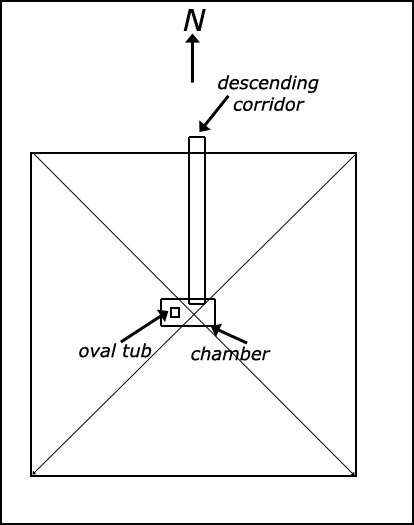
|
Below you can see the descending corridor, which is lined up with the North-South axis; the underground chamber which is oriented on the West-East axis, and the mysterious oval tub about which we will talk later. Neither the descending corridor nor the chamber has a roof anymore. At present they are both open to the sky. The roof probably collapsed and some of these stones have been taken away over the millennia. |
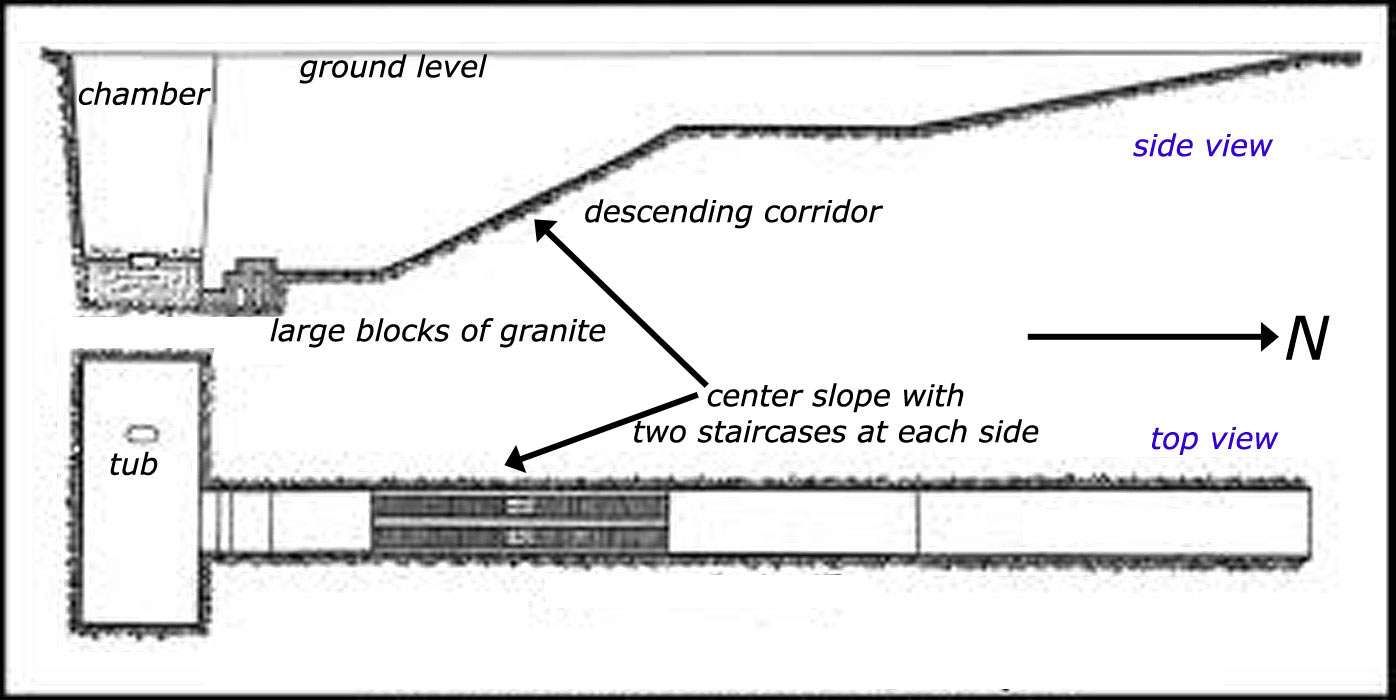
|
The descending corridor is steep, and for some reason it has a horizontal section about halfway down. Its walls, being cut from bare rock, are smooth, as are the walls of the chamber below. The entire floor of the chamber is dressed with massive granite blocks. The blocks measure 4.5 m (15 feet) long and 2.5 m (8.2 feet) thick and weigh up to 9 tons each. At the West end of the chamber is a curious feature: an oval tub cut into one of the granite blocks of the foundation. It is usually referred to as a sarcophagus, but this is clearly not the case as we will see later. The few references you can find on the internet are inaccurate and I wonder if anybody has ever read the original description of this feature when it was first discovered. For example, Wikipedia mentions: "According to Barsanti, small traces of a burial were found inside the sarcophagus, but unfortunately they were never examined closer and today they are lost." But when you read Barsanti's original description, he did not call it a sarcophagus, and he did not find traces of a burial inside, but something quite different. |
|
The Italian archaeologist Alessandro Barsanti started excavating the subterranean structure of the Northern Pyramid of Zawyet El Aryan in 1904. He was the only one who has ever examined this structure. He left us some very interesting descriptions. His original (French) report that was published in the Annales du Service des Antiquités de l'Egypte, Tome VII, of the Institut Français d'Archéologie Orientale du Caire, in 1906 (page 260-286). You can find my translation into English here. From this text I will highlight some paragraphs that show the uniqueness of this subterranean structure. |
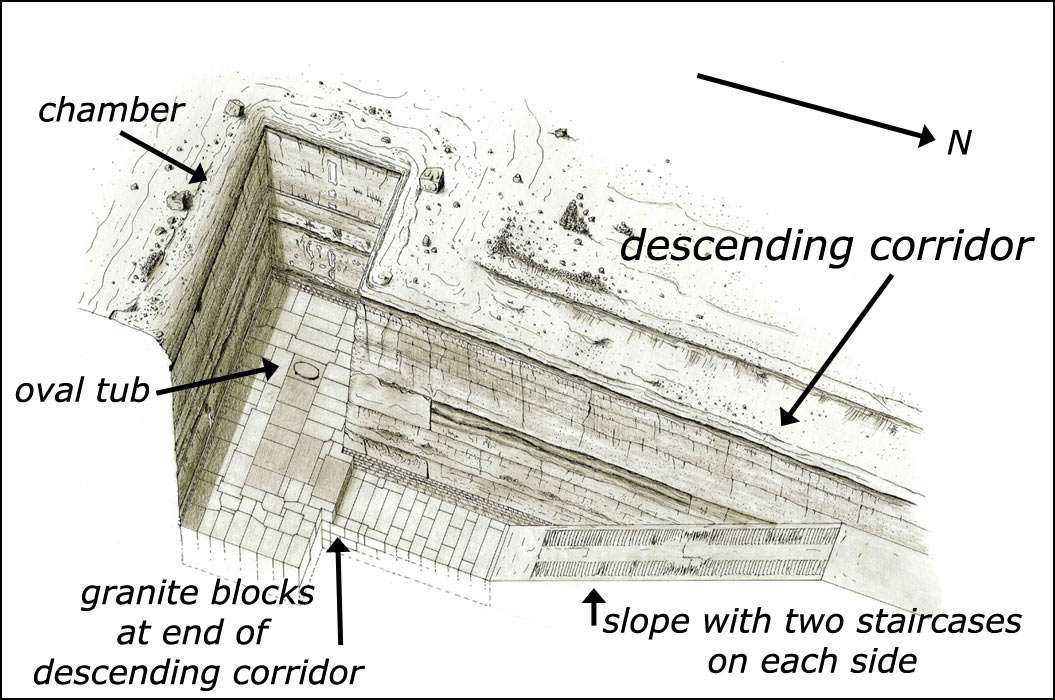
|
The descending corridor is 100 meters long, 25 meters wide and 30 meters deep. Alexandre Moret, a French Egyptologist (1869-1938) who visited the site after it had been excavated by Barsanti), was impressed by the sheer quality of the construction: "The walls of the cavity (corridor and chamber) are simply cut out from the the limestone plateau; the profiles have such a sharpness to it that it seems that they have been cut out from the rock with a stretched thread, as if it was a clod of butter." (Source: Au Temps des Pharaons.) This degree of levelness and sharp corners is typical for all the ancient stone construction around the world, dating from the Atlantean period. I think it is significant that he made this remark, as he did not say that the walls were chiseled from the rock, as this would leave tell tale signs of the chisels used. Halfway down the corridor there is strange slope which is smooth at the center, but has on each side a staircase. Moret remarks that this staircase shows signs of usage. Another reason that this was not an unfinished pyramid. The following sketch shows were the slope with the two staircases are located. |
|
When Barsanti started clearing the corridor, he found among the rubble large limestone and granite blocks, "Sometimes, they were of considerable dimensions, and some of them weighed three and four tons." He thought the ancient Egyptians had thrown them in to fill up the space, but they probably were part of the roof of the corridor that collapsed. It was the first indication that the builders had also used large heavy stone blocks. Bear in mind, that the supposed builders, the Dynastic Egyptians, only had copper, bronze and iron (which is soft) tools. At present we can only cut granite with steel wire or saws that are diamond tipped. Dynastic Egyptians did not cut these large granite blocks, and certainly did not have the ability to move them from far away quarries. Why use multi-ton granite blocks to build a tomb? Barsanti mentioned that the first granite block he found was pink granite. later it turned out that the entire stone pavement of the chamber was made from pink granite. The pink granite (which was also used to make the stone coffer and walls and ceiling of the King's chamber, and the Grand Gallery in the Great Pyramid of Cheops, and in other pyramids) came from the quarries at Aswan, 934 km, or 580 miles, south from Giza up the Nile river. Quite a distance to haul multi-ton blocks on supposed wooden rollers and pulled by hundreds of slaves...in the sand! The ancient Atlantean builders must have had a good reason to incorporate large granite blocks in their constructions. Needless to say, they also had the means to transport multi-tons blocks of stone. By the way, these megalithic, often granite, blocks were used all over the world in these ancient buildings. some people say that granite was used because of the high quartz content, which would allow for piezo-electric effects. |
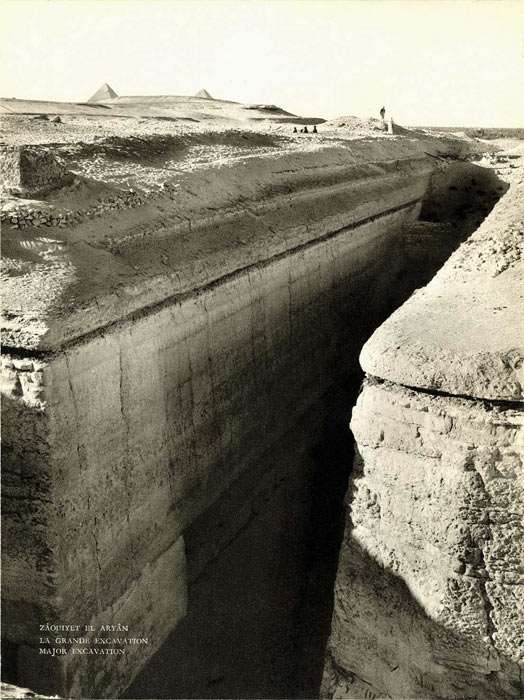
|
The descending corridor cut out of the limestone bedrock. |
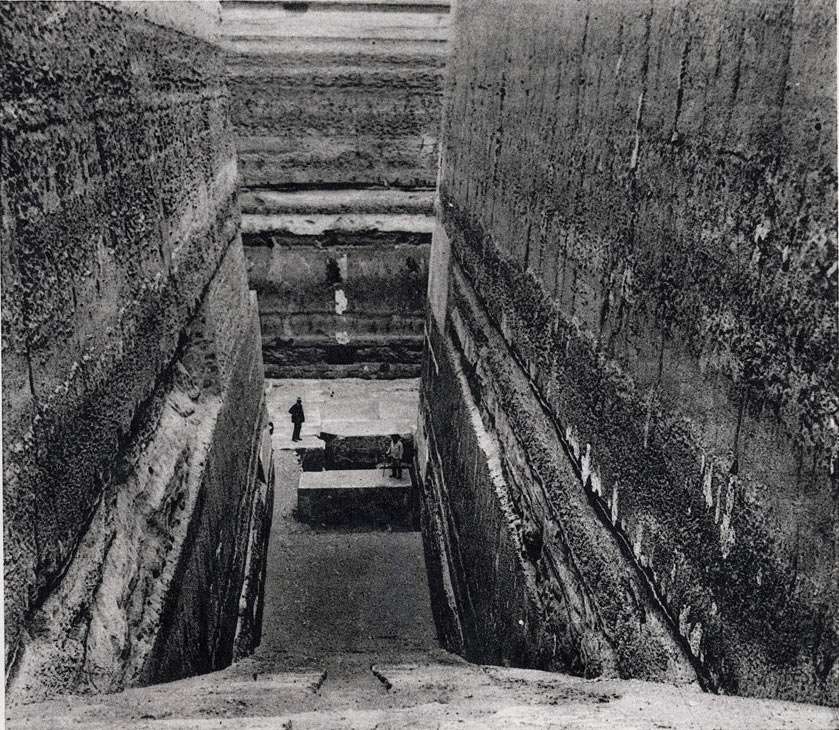
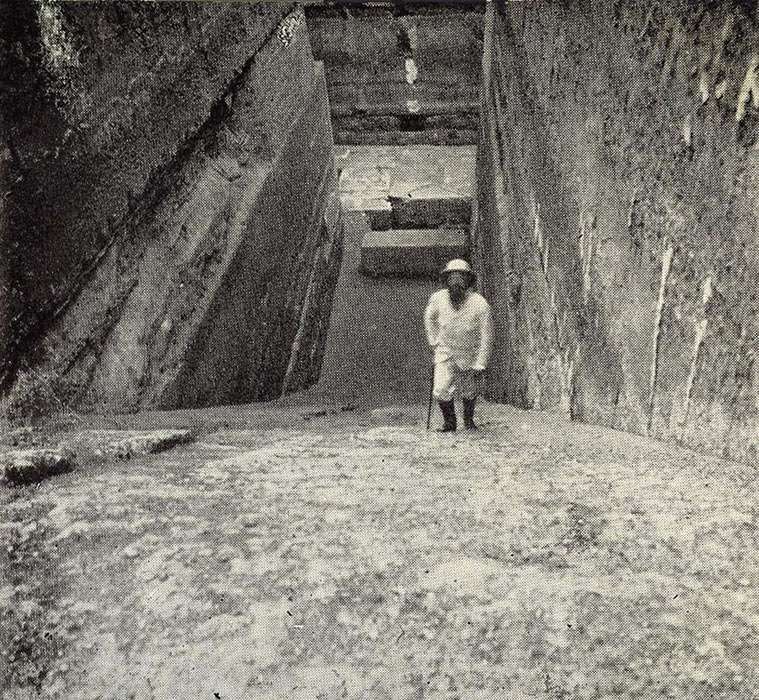
|
The descending corridor, looking down towards the chamber, with large granite blocks of stone at the bottom end of the corridor. |
|
When clearing the descending corridor Barsanti found at the bottom end a strange construction made from granite blocks: "Right at this point we encountered a large block of granite weighing about thirty tons, which was placed horizontally on the surface of other blocks which seemed to form the pavement of the pit. At first I imagined that I was standing in front of the gate of the monument, but descending still lower, I met two other blocks of the same or similar size, which were placed side by side, then below two blocks, also of granite, and 1 meter 6 centimeters thick, but placed on the same rock." Large granite blocks of 30 tons! It becomes really obvious here that whoever made them had no problem transporting these heavy stones, let alone bringing them down here and placing them around. Barsanti also got the first impression that the floor of the chamber behind it was also made of granite blocks. |
|
Having come into the underground chamber, Barsanti found that the entire floor was made of large granite blocks. Think about it, if you want to build an underground burial chamber, you can easily cut a nice chamber out of the limestone rock. Why go the immense effort of quarrying, moving and paving the chamber with enormous granite blocks? The original builders did want to go through this trouble because it was essential for the technological purpose of the construction, whatever that was. |
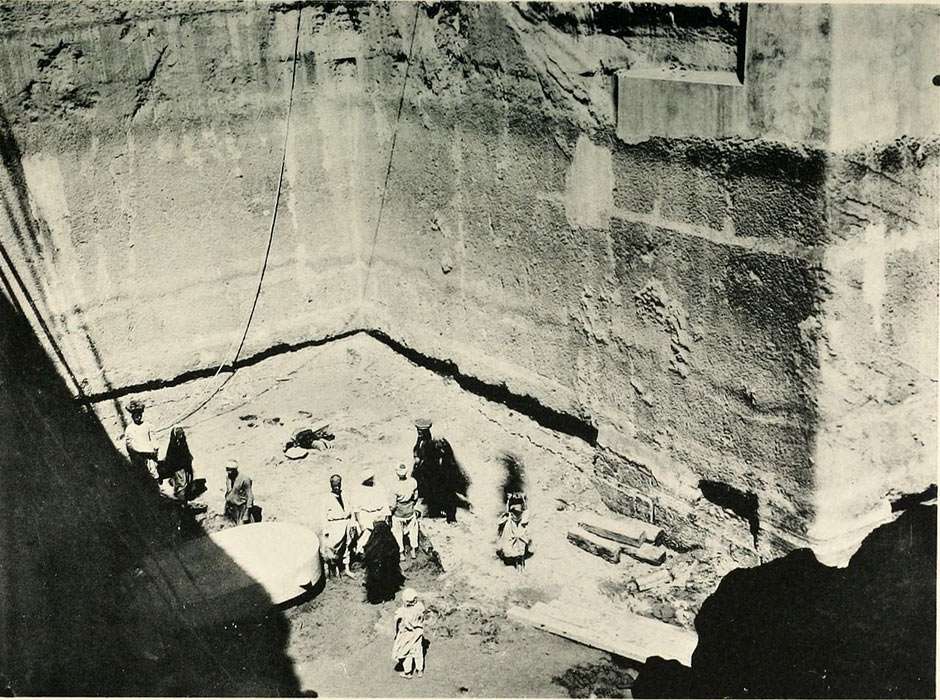
|
Looking down into the chamber, with the tub at the West end, still sealed with its oval lid. |
|
Although Barsanti never called it a sarcophagus because he clearly saw that this was not the case, modern archaeologist still call it so. Alexandre Moret, the French archaeologist mentioned before, also did not call it a sarcophagus; he called it a vat: "In one of the granite blocks an oval vat (une cuve ovale, in French) has been cut out; it is two meters long and one meter deep; a beautiful lid with four ear cups protects it; The whole thing is polished like a mirror and shaped with the same care as an ornament." I call it the Tub, because Barsanti said that at one time it had contained a liquid based on the signs he found inside when he opened the sealed vessel. This is Barsanti's description which is quite intriguing. I doubt if anybody today has ever read the original French text: "While this search was continuing on the north side, almost in the center of the west side, on March 12, I discovered an object of an entirely new form. It is a large oval vat (Plate III), made of pink granite, polished like a mirror, and with a depth of 1 meter and 5 centimeters. It is carved out of one of the blocks of the pavement which occupies the bottom of the pit, and the Egyptian architects had taken their measures carefully to protect it. They had spread over the lid a layer of lime, and over the lime a thick bed of well-spread clay, which entirely prevented it from contact with the limestone blocks stacked over it. These had, moreover, been placed regularly on the clay side by side, so as to enclose the precious form with a kind of insulating protection. The lid was luted in the vat with plaster, and it was with real emotion that I put myself in a position to lift it. All precautions taken made me hope that the contents would be most precious, but I was once more deceived: when the inside of the tank appeared, I found it completely empty. I only noticed that the side walls were lined with a black band that was 0 meter and 10 centimeters in height. It is probably the very light deposit of some liquid enclosed in the vat as an offering or libation, and which would have evaporated over the years. It has been hypothesized that this tank was an unused sarcophagus, but I do not think so. The care with which it was protected, proves that it contained something, and the blackish deposit indicates the nature of this content. One would not have taken the precaution of concealing it under an enormous mass of blocks if it had been empty at that time." We don't know what this vessel was used for, or why it had to be constructed this way. It is a most unusual form and shape, but it seems to have been extremely important to the original builders, because of the extreme care they took to seal this vat water tight, and to protect it with large stones. |
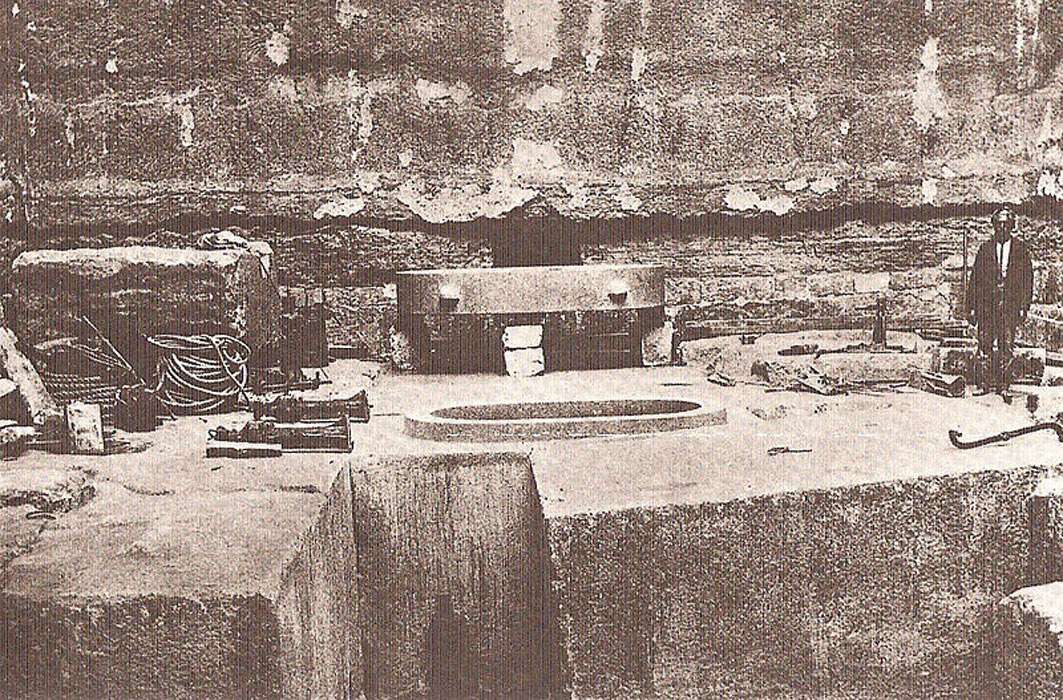
|
The oval tub, in the middle of the picture, cut out of a granite block. The lid has been removed from the tub and is now sitting on a pile of stones next to the South wall. |
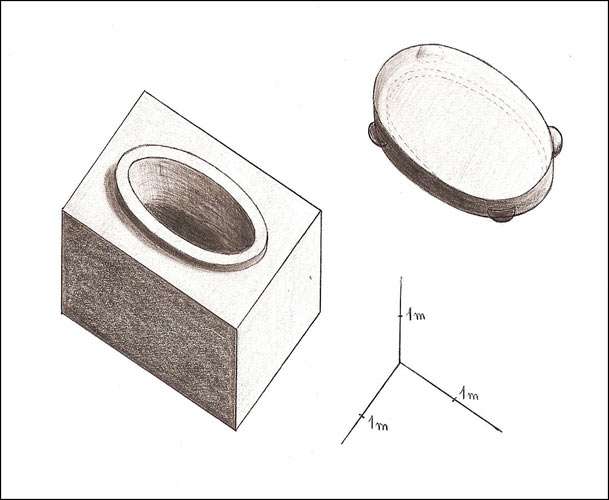
an artist's rendering
|
Although not much is left of the Northern Pyramid of Zawyet El Aryan, we can point out some features that make it not a tomb but a technological construction, whose purpose is still unknown to us. In this pyramid, but also in other pyramids, the builders went to the trouble of quarrying, hauling from a far away quarry large multi-ton blocks, even up to 30 tons for one piece, which were apparently very necessary to use in the construction of the underground chamber. Totally unnecessary if it only a tomb. Also take in mind, granite can only but cut by machines. The tub is most the interesting of all. Why cut it out of one of the pavement granite blocks? It had a perfectly fitting granite lid on top, and it was polished like a mirror on the inside. These features create a very strong link with the Serapeum subterranean granite coffers, of which I have written an article. You can read it here. These oversized coffers, also mislabeled as tomb (for bulls!), had perfectly fitting lids, and their interior walls were not only leveled to a fraction of an inch and had perfect ninety degree angles, and they also were polished like a mirror. By the way, the Serapeum coffers cannot be made or duplicated by our modern day technology. So, why was is necessary for the tub to have a mirror smooth interior? And why was it oval, which is more difficult to make than a mere rectangular box? The answer to the mirror like polish of the interior walls of the tub may lie in the fact that it was made to contain a liquid. In that case smooth walls are easy to clean. The contents of the tub must have been very important to the original civilization that was using the pyramids. I surmise that it was after the destruction of the pyramid (by an explosion), that the caretakers sealed of the tub with a layer of lime and lime stone blocks. They might also have filled up the chamber and corridor with stones and rubble. It is quite possible that these people eventually didn't survive the catastrophe, and the thus sealed tub remained that way until Barsanti uncovered it again. There might be more underground passages not yet discovered, as Barsanti noticed that after a heavy rain, "the pit was flooded to the height of three meters. Towards midnight the water dropped abruptly by about one meter. I can only explain this phenomenon by supposing it to be engulfed in some subterranean tunnel, large enough to contain 380 cubic meters of water, and in fact I found traces of moisture in the joints of the blocks for a long time." Unfortunately no further excavations ever happened to this day. One wonders why the Egyptian authorities are not interested in further excavation. They are always so eager to discover a hidden tomb filled with treasures. And why it was placed in a military zone. Thus, plenty of mysteries still remain. |